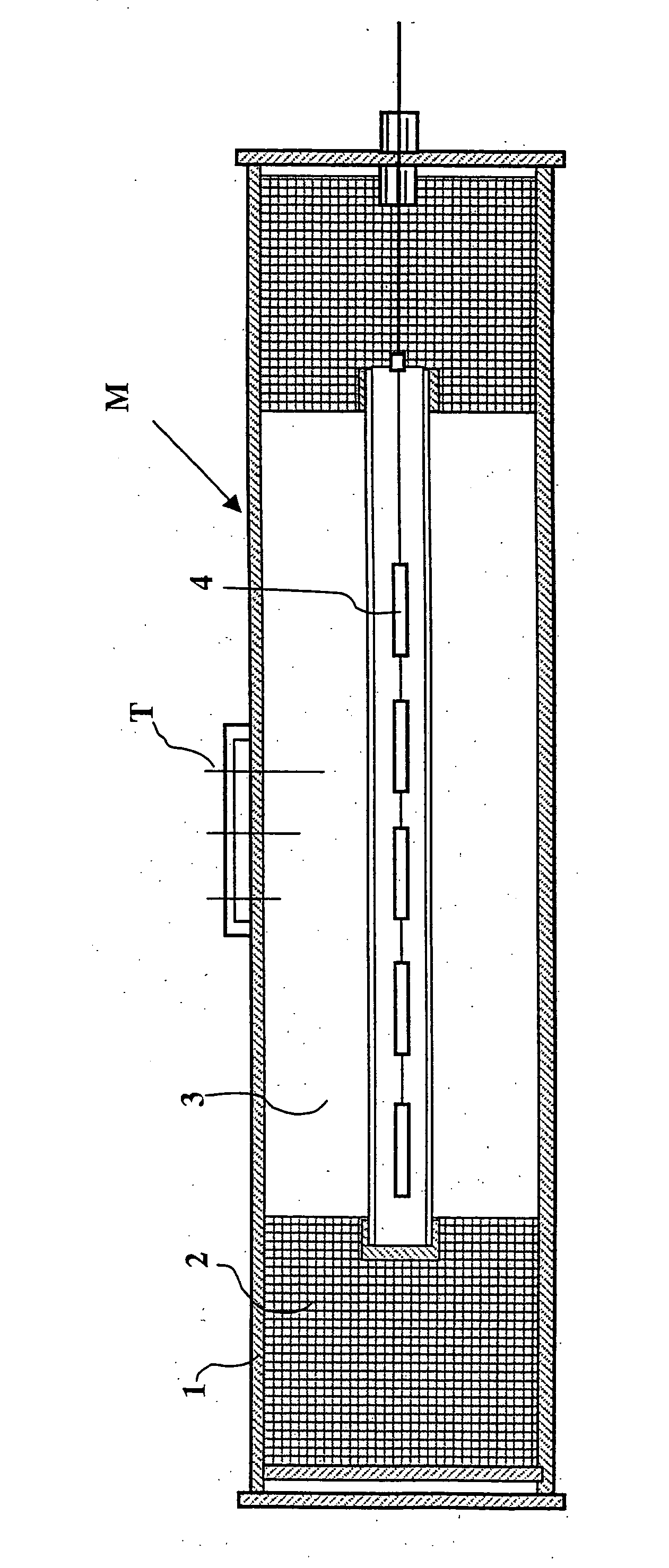Thermal insulation gel with controlled crosslinking for petroleum hydrocarbon transmission lines
a technology of petroleum hydrocarbon transmission lines and thermal insulation gels, which is applied in the direction of textiles, textiles and papermaking, chemical/physical processes, etc., can solve the problems of difficult implementation, high cost of maintenance and servicing operations, and major drawbacks of crude oil congealing
- Summary
- Abstract
- Description
- Claims
- Application Information
AI Technical Summary
Benefits of technology
Problems solved by technology
Method used
Image
Examples
example 1
Comparative Test with a Conventional Thickener
Base=Linear paraffin Linpar® C18-C20 Gelling agent=Kraton G 1651 E vs. bentone (Thixogel® VP) Testing temperature=Cycles 1 and 2
The percentages in the examples hereunder are expressed in mass of active substance.
TABLE 1Characteristics of the gelsPercen-tageKraton ® G 1651 EThixogel ® VP4<< Firm >> gel. No bleeding.Fluid solutionThermal cycle stability8<< Firm >> gel. No bleeding.Fluid solutionThermal cycle stability10<< Loose >> gel. Bleeding.Thermal cycle instability12<< Loose >> gel. No bleeding.Thermal cycle stability15<< Firm >> gel. No bleeding.Thermal cycle stability
The example given above clearly shows the advantage afforded by physical gelling agents in relation to conventional thickeners for a given base, much lower proportion of material used, higher gel quality and stability.
example 2
Manufacturing Process and Direct Use
TABLE 2Manufacture and use of the productsKraton ® G 1651Thixogel ® VPManufac-Dispersion of the powderedManufacture of a bentone-turepolymer at 40° C. if the basebased grease followed byhas to be melted, or at ambientcrushing, deaerationtemperature (20° C.) in theGel having a certainpresence or not of otherconsistencypolymers or dispersantsLiquid dispersion of<< swollen >> polymer powdersUse inFilling with the fluid liquidFilling by pumping underthe linesdispersion from the bottompressure (150 bars) andIn-situ gelation with<< vacuum draining >>temperature (example: at 80° C.throughout the linegel at 4% gel time = 4 h) orRisk of << air pockets orothersbubbles >>
This example shows the ease and flexibility of use of a physical gel with in-situ crosslinking and controlled initiation, for example by temperature.
example 3
Product Conditioning Process in Case of no Direct Use
Temper-BasesatureCompositionAspectPot lifeLinpar20° C.8% Kraton GHeterogeneous3 to 6C101651swollen powdersmonthsdispersionLinpar20° C.6% Kraton GHomogeneous3 to 6C101651dispersionmonths2% Kraton G1702Linpar 40° C.(1)8% Kraton GHeterogeneous3 to 6C18-201651swollen powdersmonthsdispersionLinpar 40° C.(1)6% Kraton GHomogeneous3 to 6C18-201651dispersionmonths2% Kraton G1702
(1)It is recommended to keep these products or to bring them to a temperature of 40° C. prior to use (crystallization temperature 28° C.).
It appears that, in cases where the product is not directly used from the conditioner, incorporation of another polymer allows the homogeneity, the stability and the pumpability of the product to be improved.
PUM
| Property | Measurement | Unit |
|---|---|---|
| Temperature | aaaaa | aaaaa |
| Fraction | aaaaa | aaaaa |
| Fraction | aaaaa | aaaaa |
Abstract
Description
Claims
Application Information
 Login to View More
Login to View More - Generate Ideas
- Intellectual Property
- Life Sciences
- Materials
- Tech Scout
- Unparalleled Data Quality
- Higher Quality Content
- 60% Fewer Hallucinations
Browse by: Latest US Patents, China's latest patents, Technical Efficacy Thesaurus, Application Domain, Technology Topic, Popular Technical Reports.
© 2025 PatSnap. All rights reserved.Legal|Privacy policy|Modern Slavery Act Transparency Statement|Sitemap|About US| Contact US: help@patsnap.com



